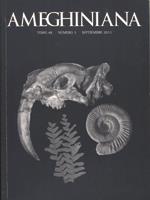Natalia Zimicz
Ameghiniana 48 (3), 358-379, (1 September 2011) https://doi.org/10.5710/AMGH.v48i3 (472)
KEYWORDS: Facetas de desgaste, Oclusión dentaria, Masa corporal, Herbivoría, Marsupiales sudamericanos, Cambio climático, Wear facets, Dental occlusion, body size, herbivory, South American marsupials, Climatic change
WEAR PATTERN AND OCCLUSION IN THE MASTICATORY SYSTEM OF EXTINCT ARGYROLAGOIDEA (MARSUPIALIA, POLYDOLOPIMORPHIA, BONAPARTHERIIFORMES). The Argyrolagoidea (Mammalia, Marsupialia, Polydolopimorphia, Bonapartheriiformes) display a pattern of cusp contact that is quite different from any other group of South American metatherians during dental occlusion. The resulting pattern of wear facets is also exclusive for this group. In part, this is due to the highly derived molar morphology of argyrolagoids as compared to the generalized tribosphenic pattern. The location and relative development of wear facets indicate that chewing movements were composed of propalinal and ectental components, resulting in an oblique motion. This type of masticatory dynamics correlates with the argyrolagoid molar pattern, including a reorganization of cusps and the addition of neomorphic structures. This pattern of molar wear, the occlusal movements, and the acquisition of hypsodonty strongly support the hypothesis of an herbivorous diet for this group. The occurrence of hypsodonty in South American metatherians already by the early Oligocene appears to be a remarkably rapid response to environmental changes. Body mass estimates are consistent with those of many small herbivores (i.e., rodents).

